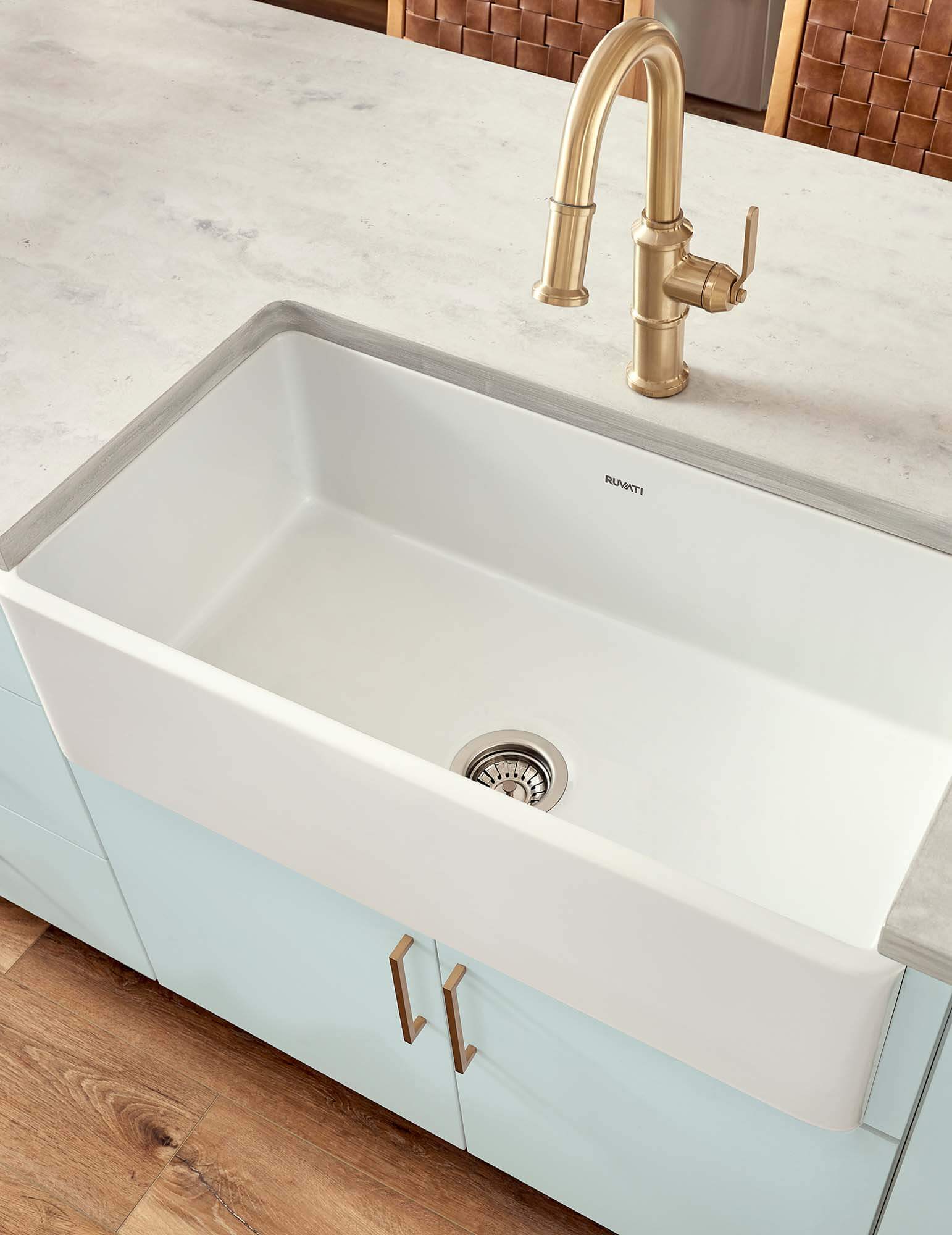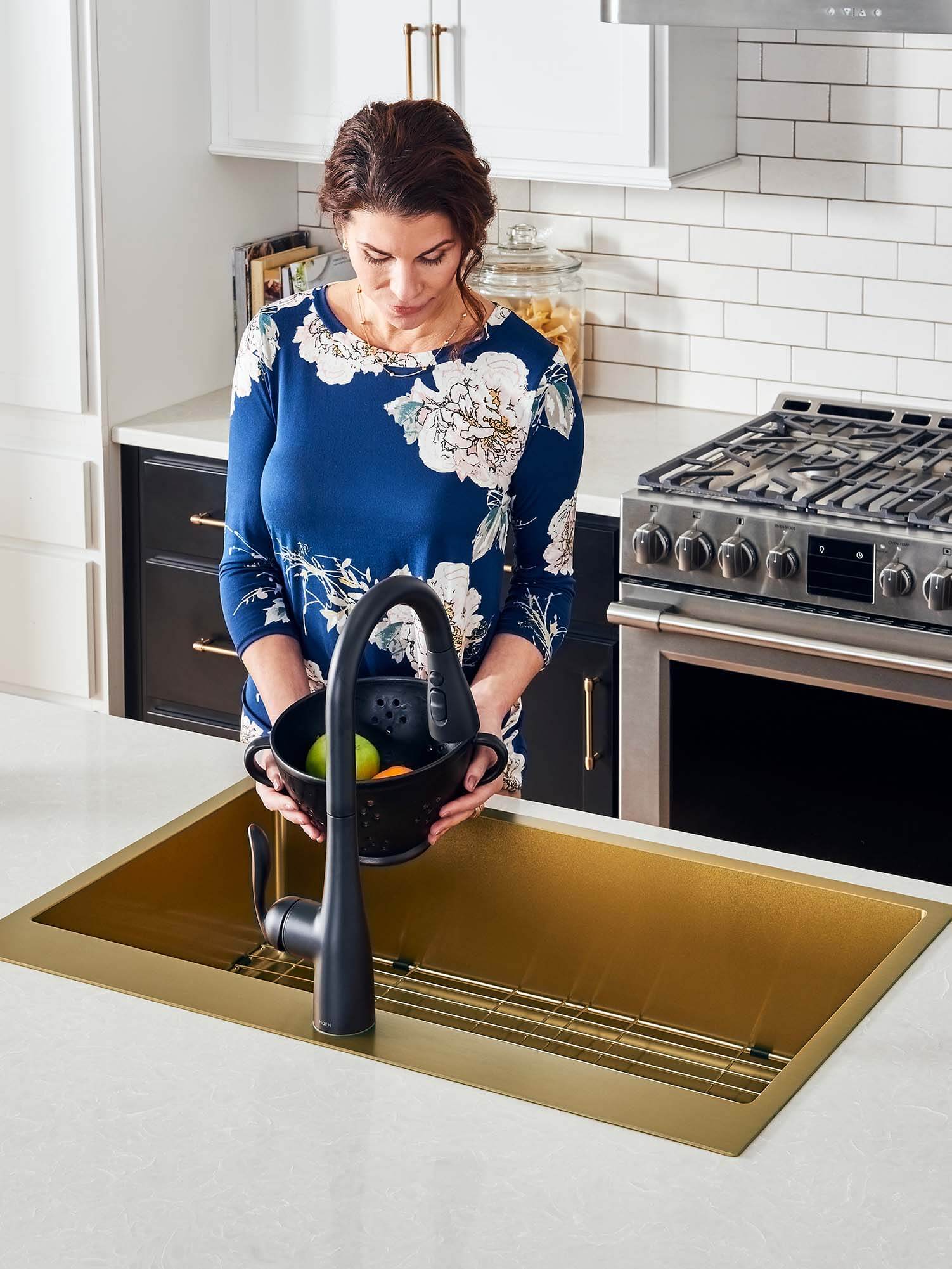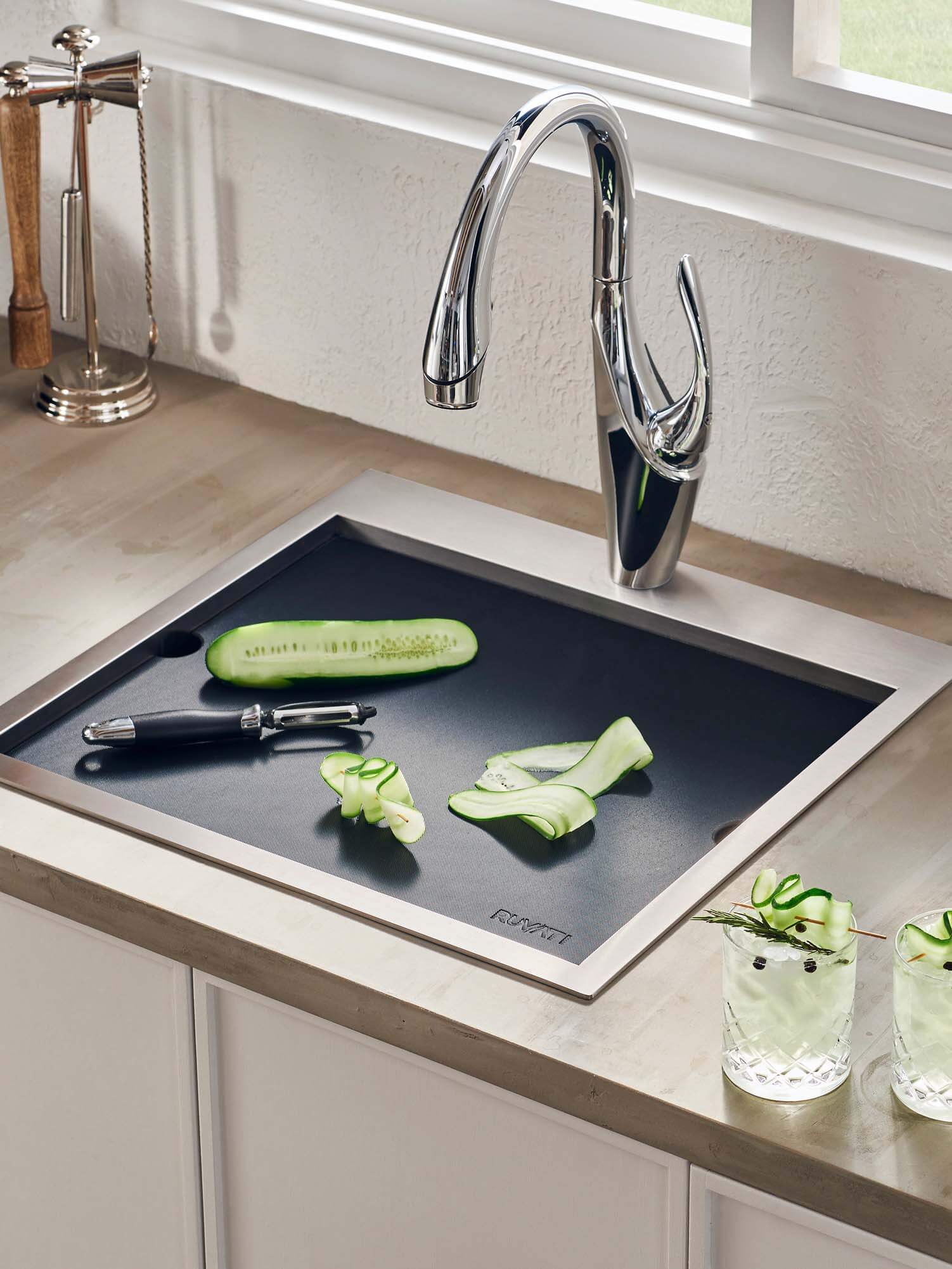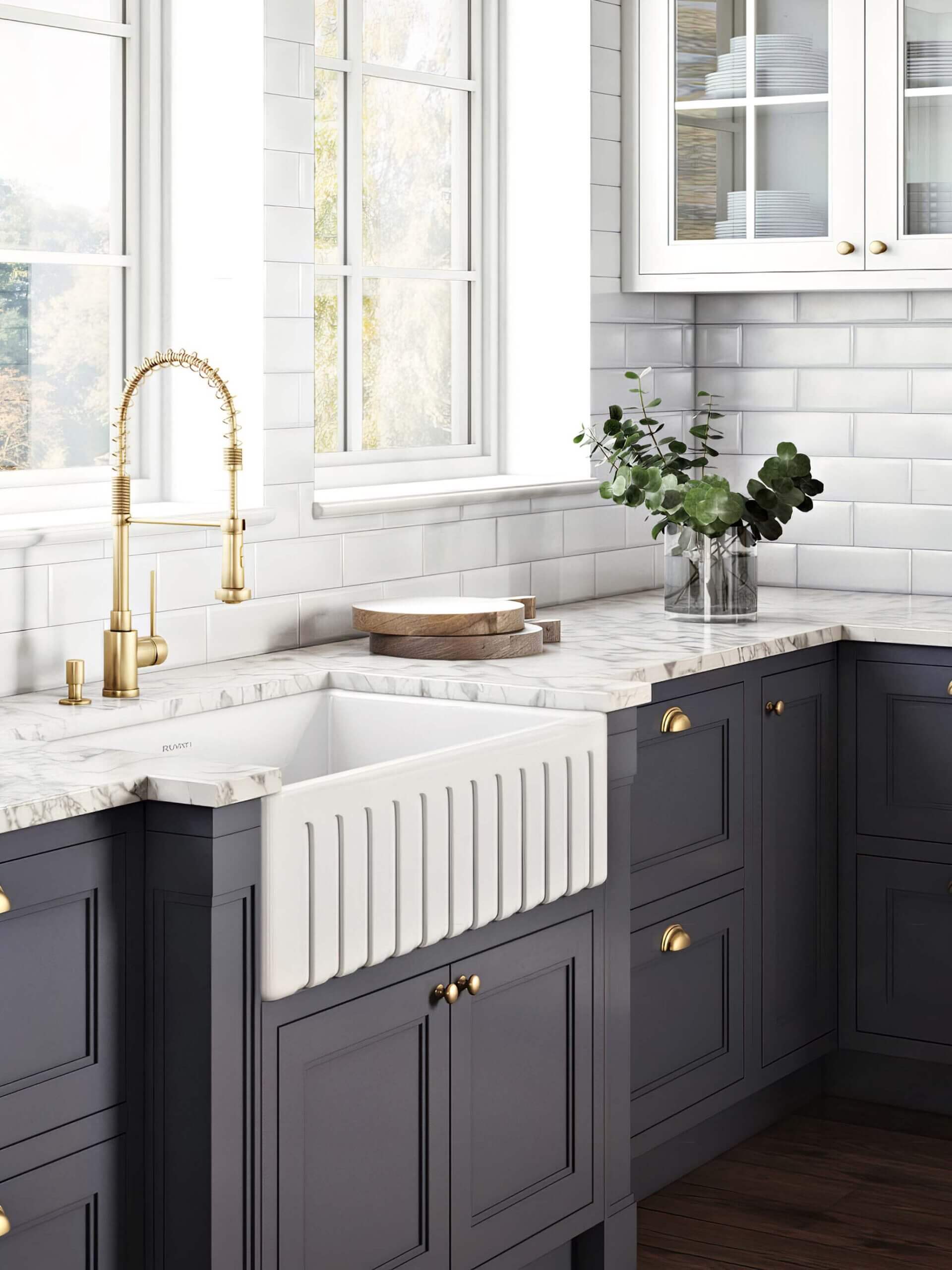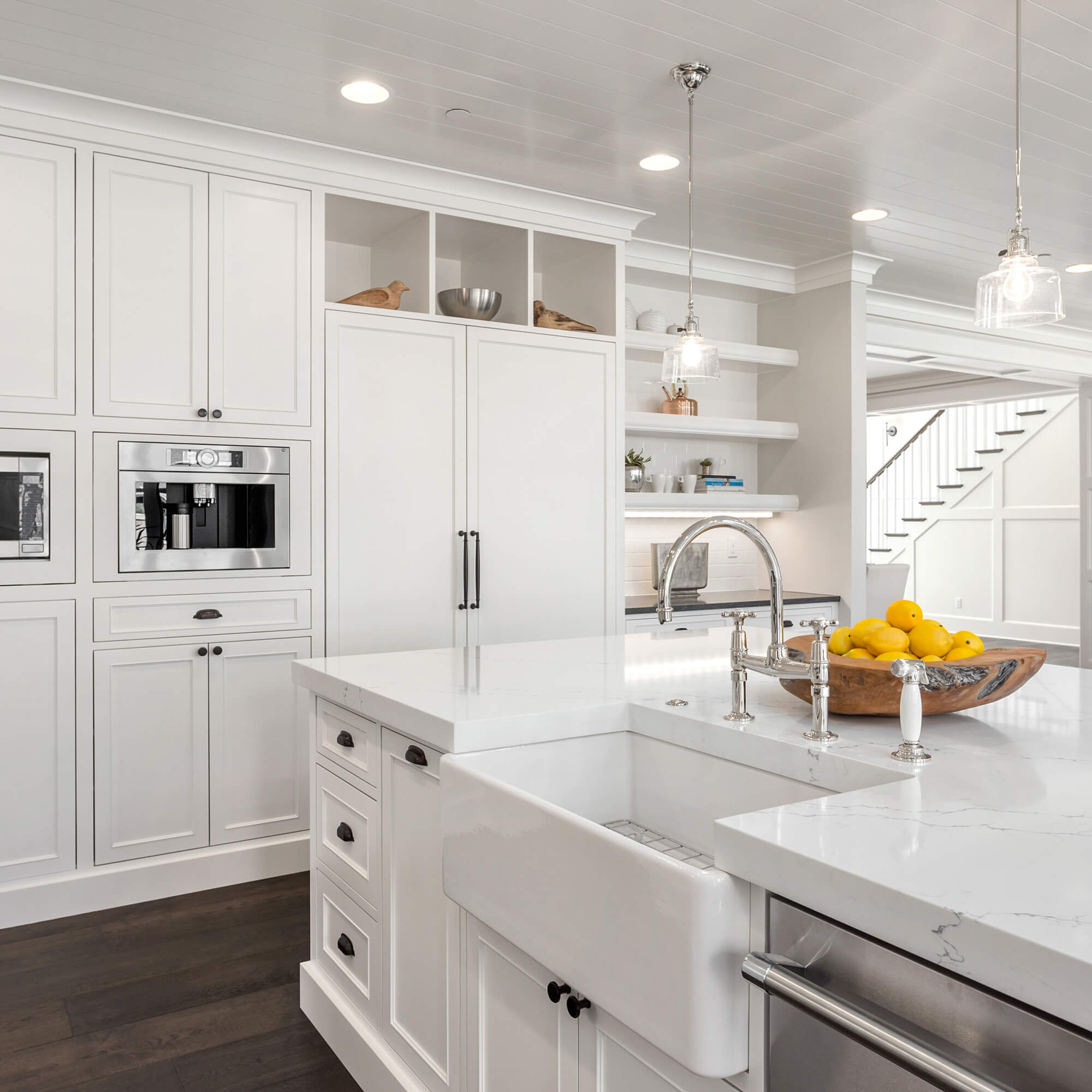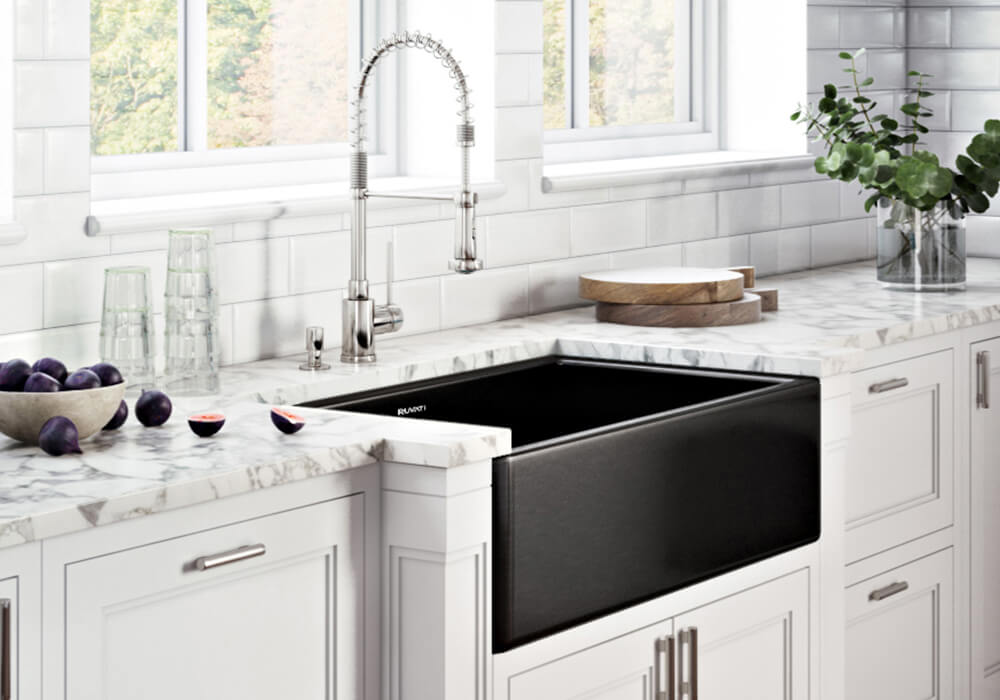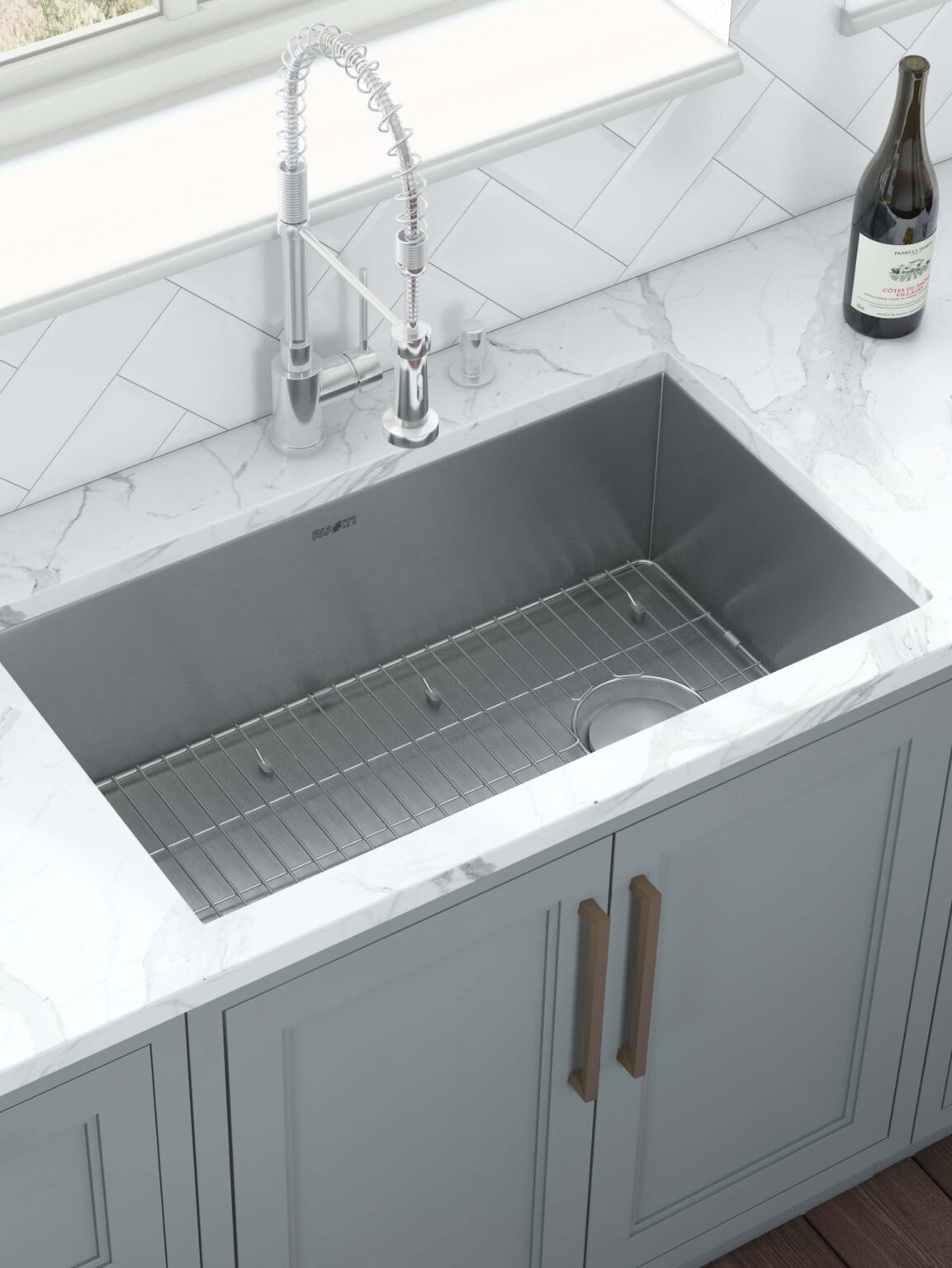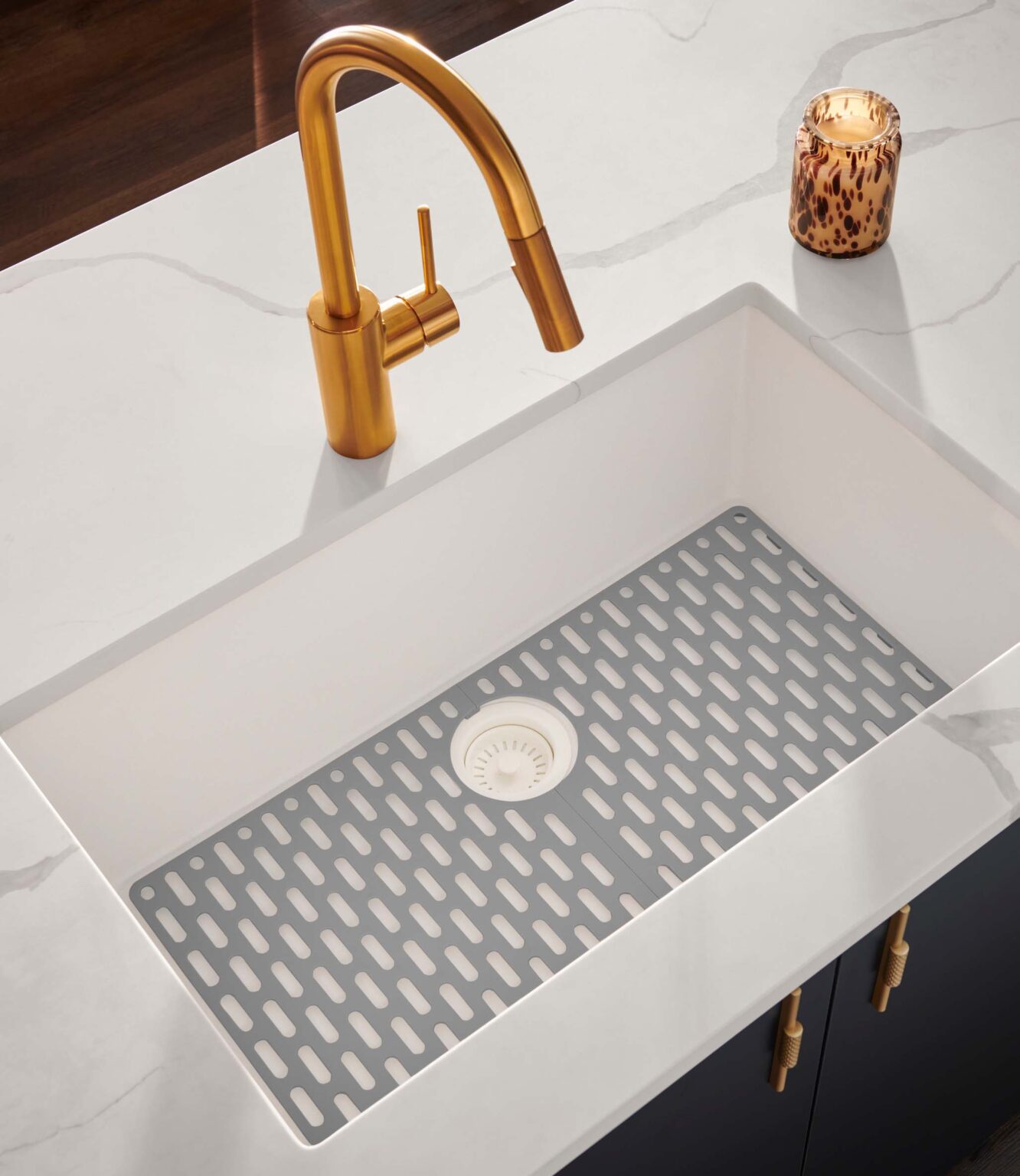On the quest to find the perfect sink, perhaps these two heavyweight contenders have piqued your interest, but which one’s the best fit? In this guide, our goal is to explain the pros, cons, and key differences between these two sink materials. We’ll tackle longevity, cost, maintenance, and Installation. By the time you finish reading, you’ll be well-equipped with the wisdom needed to make a selection that perfectly suits your kitchen remodeling aspirations.
Key Differences
Quailties | Fireclay | Cast Iron |
|---|---|---|
| Material Composition | Naturally occurring clay-based ceramic | Enameled cast iron |
| Aesthetics | Timeless, rustic charm | Glossy, traditional elegance |
| Maintenance and Cleaning | Easy to clean with gentle cleaners | Requires regular maintenance and non-abrasive cleaning |
| Durability | Resistant to breaks, tough material | Robust but prone to chipping and discoloration |
| Price | Generally less expensive | Often more expensive |
| Environmental Impact | Made from recyclable materials, less energy-intensive | Coated with enamel that can chip and end up in landfills |
The Eternal Elegance of Fireclay Farmhouse Sinks
For over 200 years, these sinks have been celebrated for their strength and practicality in European kitchens. Ruvati is one of the few manufacturers to source true fireclay from Italy. The country has a strong tradition of artisanal and industrial ceramics production, and the availability of locally sourced fireclay, producing one-of-a-kind sinks. You’ll find them to be a perfect blend of form and function, with a charm that enhances your kitchen’s aesthetics. From their origins to their benefits and their place in today’s kitchen, understanding them will help you make an informed decision.
What is Fireclay?
Fireclay material is celebrated for its strength and durability. It is resistant to deformation and capable of withstanding high temperatures with ease. Fireclay as in its name, is a naturally occurring clay-based ceramic that comes in many shades of white. It is fired in a kiln at extreme temperatures to create an incredibly durable kitchen sink material. The essence of fireclay lies in its unique manufacturing process where the clay is glazed and then re-fired, creating a lustrous, enamel finish that’s not only beautiful but extremely hard-wearing. With this material, you’re investing in a sink that seamlessly combines functionality with aesthetic appeal. Now, let’s delve into the benefits of opting for this style.
Benefits of Fireclay Sinks
Now that you’re familiar with what the material is, we’ll explore the five key benefits of choosing this material. Firstly, they offer unrivaled reliability. They resist scratches, stains, and heat, ensuring a long lifespan. The benefits of fireclay also include corrosion and fade resistance, maintaining their vibrant look for years. When considering one or the other, the fireclay’s large size provides ample space for washing large items, adding convenience to your daily kitchen tasks. Moreover, they are compatible with garbage disposals, enhancing kitchen functionality. Finally, it adds a timeless aesthetic to any kitchen style. With an elegant look that never fades, they’ll look new for decades. Stay tuned to explore more about fireclay kitchen sinks today.
Fireclay Kitchen Sinks by Ruvati
You’ll find that a significant number of modern kitchens today feature fireclay sinks, not just for their unmatched toughness, but also for their timeless aesthetic appeal. Crafted from a unique natural white clay, the Fiamma collection from Ruvati, is a testament to centuries-old Italian craftsmanship, offering not only strength but also a touch of art in their design. With various installation options, including a reversible model that offers a fluted or flat front design, the Fiamma collection offers a more customized experience when it comes to your strong, beautiful kitchen sink. From black to brushed gold, infused with real 24K gold, there is bound to be a sink in the Fiamma collection to fit your design needs. When compared to cast iron, these sinks are extremely popular, standing out for their resistance to chips, cracks, and abrasions. Whether you’re searching for a sink for your kitchen or researching materials on the market, fireclay is a cost-effective choice that harmonizes with the overall style of your sink, adding a touch of luxury without compromising on practicality.

Cast iron sinks are prone to flaking and chipping due to its dual material manufacturing process.
Why are Cast Iron Sinks so Heavy
Comparable to fireclay, its iron competitor is a popular material when it comes to cooking, cleaning, and kitchen products. You might own cookware, or more specifically a cast iron skillet. Ever wonder why cast iron is so heavy? This is largely due to the material they’re made from: cast iron. Cast iron is different from iron as it smelts various scrap metals and alloys with iron, which is then poured into a cast, giving it sturdiness and strength. This contributes significantly to the weight of the sink, making it difficult to move and place when compared to stainless steel sinks. But once it’s in place it’s robust and long-lasting.
What is the Cast Iron Sink Made From?
In spite of their heavy weight, they are a popular choice in many kitchens due to their solid and classic appeal. Cast iron is renowned for its strength and integrity and is often the go-to choice for those seeking a lasting investment. These sinks are made from heavy-duty enameled cast iron, which gives them an attractive glossy finish. This coating also makes them resistant to stains and easy to clean, adding to their appeal. However, it’s their substantial weight that attests to their robustness, making them suitable for withstanding heavy use over time.

This is what a cast iron sink looks like when it loses its protective enamel coating.
Durability of Cast Iron Kitchen Sinks
Despite their considerable weight, they offer exceptional reliability that’s hard to beat. This toughness makes them a worthy competitor in the sinks debate. The sturdiness of it is due to the strength and weight of the material itself, along with the enamel coating that adds an extra layer of protection. The downside? These sinks are heavy, and easily susceptible to rust, demanding extra care during installation to ensure they’re properly supported. But don’t let the weight deter you! Their sturdiness makes them a solid investment for your kitchen.
Cast Iron Farmhouse Sinks
While the substantial weight of these sinks might initially seem like a drawback, it’s this very heftiness that contributes to their robustness, making them an excellent choice for farmhouse-style kitchens. The coating on cast iron adds a classic aesthetic that blends seamlessly with the rustic charm of farmhouse sinks. This sink style, however, may require extra installation support due to its weight, which could impact your kitchen renovation budget. Regardless, the nearly indestructible quality of iron sinks is a significant selling point. Their resistance to daily wear and tear ensures they remain functional and visually appealing for years. Now, let’s delve into the differences between fireclay and cast iron, which will help you make an informed decision.
Fireclay vs Cast Iron Sink – The Difference
When choosing between two sink styles, consider factors such as aesthetics, maintenance, longevity, cost, and environmental impact. While both offer unique advantages, they also come with their own set of challenges. Let’s compare these two popular materials to help you make an informed decision for your kitchen upgrade.
Aesthetics and Design
You’ll notice a significant difference in aesthetics and design when comparing these sinks. The farmhouse sink, often made from fireclay, can seamlessly blend into a variety of kitchen styles, providing a timeless, rustic charm. Its bright, clean lines can complement your overall style, offering a pleasing contrast against darker cabinets or countertops. On the other hand, cast irons are renowned for their glossy finish and robust feel, offering a more traditional, elegant look. Don’t expect this sink to be subtle in any way. Remember, the sink you choose can dramatically influence the overall aesthetics and design of your kitchen. So, whether you opt for the subtle elegance of fireclay or the robust eye-catching qualities of cast iron, your choice should align with your personal style and functional needs.
Maintenance and Cleaning
After settling on a sink design that fits your aesthetic preferences, it’s time to consider how much effort you’ll need to put into maintaining and cleaning your chosen sink. The enamel-coated iron heavyweight requires care and regular cleaning to avoid deterioration or chipping of the enamel coating. Using abrasive cleaners can damage the coating, so it’s essential to use non-abrasive products and wipe down after each use. Fireclay sinks, on the other hand, are more forgiving and can be wiped clean every day with gentle cleaners. Regular maintenance and cleaning will ensure both materials last longer and look better. Now, let’s move on to discuss the sturdiness and permanence of these two sink types.
Durability and Quality
Considering your sink’s maintenance and cleaning regimen, let’s now dive into the crucial aspect of longevity that distinctly sets fireclay sinks apart from cast iron sinks. When it comes to longevity, fireclay sinks tend to be more resistant to breaks. The material is incredibly tough, ensuring years of use without signs of wear and tear. Cast iron, on the other hand, is also robust but prone to chipping and discoloration over time. With proper care, a fireclay sink can last for years, maintaining its pristine look far longer than a cast iron sink. As you weigh the pros and cons of this debate, consider these factors carefully. Let’s now move on to discussing the price point of these two types of sinks.

3D models for a cross-sectional analysis of fireclay sink material (top) and cast iron sink material (bottom). Fireclay is a solid material resistant to thermal shock, such as pouring hot water into a sink during cold weather. In contrast, cast iron sinks are prone to cracking during thermal shock, primarily because enamel and cast iron expand at very different rates. This expansion difference, coupled with the variation in thickness between the two materials, leads to an increased risk of cracking.
Price Point
When it comes to the cost, there’s a significant difference between the two sinks that you should take into account. Generally, fireclay is less expensive than cast iron options. A quality fireclay can range from $400 to $1000, while cast iron sinks often start at $500 and can go all the way up to $2000 or more. This is due to the materials used and the manufacturing process. Remember, you’re not just paying for the sink itself but also the installation, which can be more challenging and costly for heavier cast iron sinks.
General Product Info:
Fireclay: The ideal choice for discerning homeowners looking for a farmhouse sink
Cast Iron: A high-maintenance rust-prone sink coated in enamel
Pros:
Fireclay: unbeatable affordability and ease of Installation
Cast Iron: A Heavyweight in Expenses and Installation Challenges
Why You Should Choose Fireclay:
Fireclay sinks are not only lighter on your wallet but also lighter in weight, making them the smart choice for budget-conscious consumers. Their affordability will leave you with extra cash to spend on other home improvements. Installation is a breeze with fireclay sinks, requiring minimal effort and expense. Enjoy various design options that cater to your unique style preferences. Repairing them is a walk in the park, ensuring your investment lasts for years to come.
Why You Might Want to Avoid Cast Iron:
Cast iron sinks may appear durable, but their high price tag might weigh heavily on your finances. The installation process can be a daunting task, often requiring additional support structures to bear the load. Enamel coating on cast iron sinks is susceptible to chipping, which can lead to rust issues. Repairs can be costly and time-consuming, making it a less practical choice for savvy homeowners.
Environmental Impact
You might not realize it, but your choice between cast iron and fireclay sinks can have a significant impact on the environment. If you’re considering the environmental impact, fireclay sinks take the lead. They’re made from natural, recyclable materials and require less energy to produce than cast iron sinks. On the other hand, cast iron sinks are often coated with white porcelain enamel which can chip and eventually end up in landfills. When considering customization, fireclay gives you more options on the market, allowing you to tailor your sink to your specific preferences. Understanding these aspects can help you make a more environmentally friendly choice. And as you ponder the environmental impact, it’s time to consider: which one should you choose? When deciding between sinks, consider your preferences, lifestyle, and budget. Think about the maintenance each type requires and how that fits into your routine. Remember, it’s not just an investment in a sink, but also in the overall functionality and aesthetics of your kitchen.
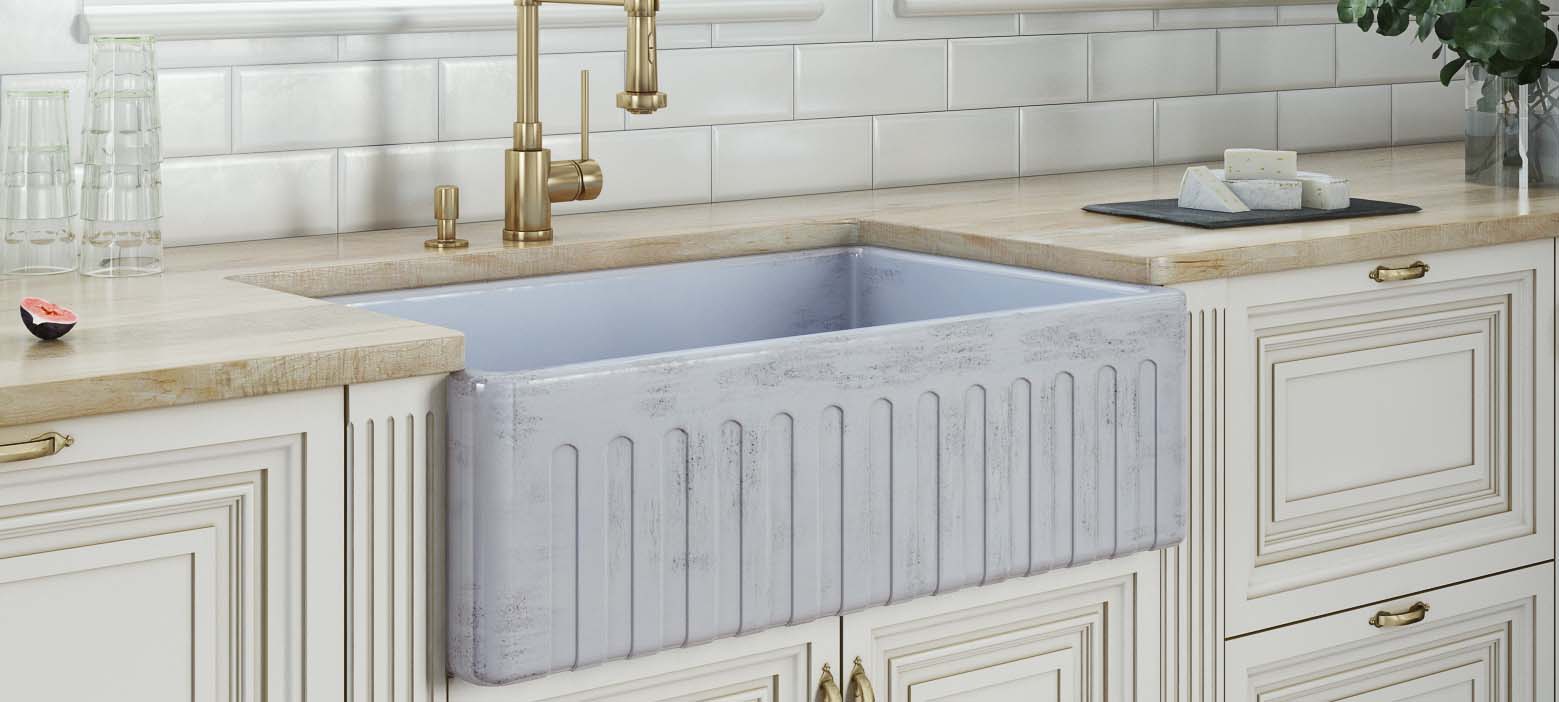
Which Type of Sink Should You Choose?
In light of all the facts, it’s crucial to consider your personal preferences – are you drawn to the classic charm and low maintenance of a fireclay, or do you prefer the durable and timeless appeal of a cast iron? When weighing the differences, think about your daily routines, aesthetics, and budget. If you’re looking to choose a farmhouse style and customize your sink, this could be the best sink for your kitchen. It’s durable, easy to maintain, and offers a variety of design options. However, if longevity and a classic look are your top priorities, you may decide between a fireclay and a cast iron sink leaning towards the clay for its longevity and timeless appeal.
Maintenance and Lifestyle
Considering your lifestyle and the kind of maintenance you’re prepared to put into your kitchen, let’s delve into the advantages and drawbacks of both styles of sinks. Fireclay sinks are easy to install, durable, and show fewer signs of use over time. They’re not susceptible to tarnish, making them a practical choice for a busy kitchen. However, cast iron sinks, while robust and traditional, can present challenges. Their enamel can wear and chip, revealing the iron underneath, and making it susceptible to corrosion. This means they require more maintenance and lifestyle adjustments to keep them looking fresh. Ultimately, your choice will depend on your lifestyle, the effort you’re willing to put into maintenance and your aesthetic preferences.
Budget and Investment
If you’re planning to shell out for a new kitchen sink, you’ll need to weigh out the cost implications and long-term investment of choosing between the two. When considering budget and investment, it’s crucial to remember that your kitchen is the heart of your home. A good sink is a long-term investment, so you want a material that lasts. Cast iron sinks are durable but can be among the more expensive sinks. They may also require more upkeep to prevent rust and chipping. On the other hand, fireclay is a more affordable option that offers longevity and easy maintenance, and it can add a charming, timeless aesthetic to your kitchen.
Cast Iron vs Fireclay: Final Decision
Ready to make a splash in your kitchen? Dive into the world of Ruvati fireclay sinks – the classic, durable, and reliable choice. If you’ve already set your sights elsewhere, well, we can’t rescue you from that decision. But before you take the plunge, remember to weigh the pros and cons carefully. A Ruvati fireclay sink isn’t just practical; it’s the beautiful addition your kitchen deserves. Sink or swim, the choice is yours!

